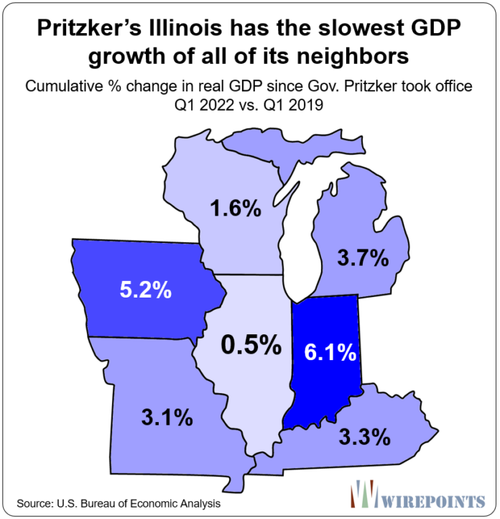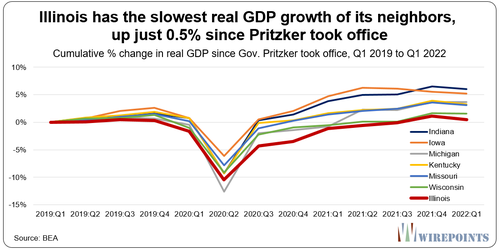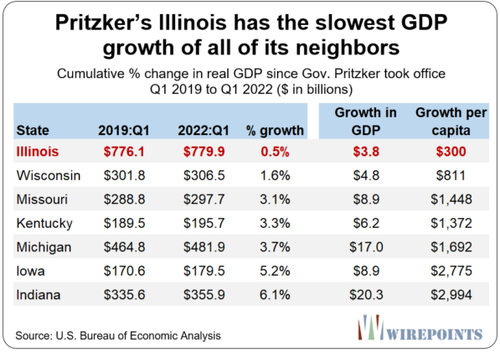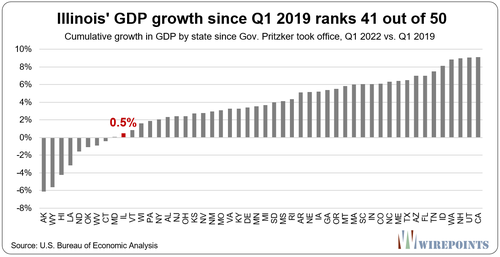With rumors heating up about Gov. J.B. Pritzker’s potential run for president and the federal governments’ recent release of GDP numbers for the first quarter of 2022, it’s a good moment to review the governor’s economic performance since he took office in 2019. Polls today consistently show economic issues as the biggest concern for Americans.
Illinois’ growth and jobs numbers aren’t pretty for Gov. Pritzker and they’re dwarfed by the much better numbers coming from Illinois’ neighboring states.
Illinois’ real GDP (adjusted for inflation) has grown an anemic 0.5 percent over the three-year period the governor has held the economic reins, according to U.S. Bureau of Economic Analysis data.
Contrast that to Indiana’s GDP increase of 6.1 percent and Iowa’s 5.2 percent. Michigan, Kentucky and Missouri all experienced an increase of more than 3 percent.
Slower-growing Wisconsin managed to grow 1.6 percent – still three times more than Illinois’ 0.5 percent growth.
Overall, Illinois’ GDP growth ranks 41st nationally (50 = worst) during the governor’s three years in office.
The governor can’t separate himself from those poor GDP numbers given the Covid policies he’s imposed on Illinoisans over the last two-plus years. His lockdowns and other mitigations have been among the most draconian in the country. A recent study published through the National Bureau of Economic Research gave Illinois an “F” for its handling of Covid – one of just five states to get an “F” – and found that the state’s policies did more economic harm than good.
In fact, Gov. Pritzker continues to declare Illinois and all its counties a “disaster area,” allowing him to maintain his executive order powers over masking, school and business closures, and vaccinations. None of Illinois’ neighboring states have any such disaster declaration or emergency rules. See our Instagram reel on Gov. Pritzker’s most recent disaster declaration.
The impact of those policies can be seen in the collapse of the state’s GDP compared to Illinois’ neighboring states. The graphic below shows the cumulative growth for each state since Q1 2019, when Pritzker became governor.
Illinois was the last to recover its economic losses from the pandemic and it has lagged its neighbors throughout.
The failure to grow has negatively impacted Illinoisans’ overall wealth and welfare. The growth in economic output over the three years was the equivalent of just $300 per capita in Illinois. In Indiana, it was 10 times higher at $2,994 per capita. The full comparison of Illinois versus its neighbors is in the appendix.
And when it comes to jobs, Illinois’ unemployment number still lags far behind the rest of the nation. The state is tied with Pennsylvania for the nation’s 4th-worst unemployment rate.
Illinois’ unemployment rate is a full percentage point higher than the national average of 3.6 percent. It’s also more than double Indiana’s 2.2 percent rate.
What if Illinois’ unemployment rate was the same low rate as Indiana’s? An additional 155,000 unemployed Illinoisans would have work today.
Pritzker’s poor economic record stands in sharp contradiction with the record he’s been pushing at the state and national level. In recent speeches, he’s been taking credit for what he claims are “balanced” state budgets, as well as Illinois’ first credit upgrades in two decades.
But those credit upgrades and “improved” finances have nothing to do with any fiscal or economic reforms implemented by the governor or the legislature. He’s passed no reforms of any consequence. In fact, most of the laws passed since Pritzker took office have increased the cost of government – we’ve documented much of that here and here.
The real difference in Illinois’ situation, which the governor fails to acknowledge, is the $186 billion in federal Covid aid that the private and public sectors in Illinois have received over the last two years. That influx of cash has pushed up the state’s tax receipts to record levels and that’s taken immediate pressure off of the state when it comes to repaying its bond holders. Illinois has gotten credit upgrades as a result, the first in more than 20 years. Just two years ago Illinois was just one notch away from a junk rating.
To buttress our point, it’s been a similar story in New Jersey and Connecticut, two of the nation’s other fiscal basket cases. There, floods of federal cash also bailed them out, resulting in the first credit upgrades in 20 years for both New Jersey and Connecticut.
An honest appraisal
If Gov. Pritzker would give an honest assessment of Illinois, he’d tell Americans that the massive inflow of COVID aid is only temporarily hiding the state’s major problems. That Illinois still has the country’s worst and biggest pension crisis. That it is one of the country’s three states with a shrinking population. That Illinoisans are punished by the country’s highest property taxes. And that Illinois is still only three notches away from a junk rating, the worst in the country.
And an honest assessment would tell Illinoisans that the state needs massive reforms to begin fixing the above.
Unsurprisingly, we’re not going to get that kind of assessment from a politician more concerned with his presidential aspirations than with his record in Illinois.
Appendix
via zerohedge





